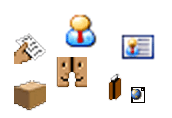Description of conditional activities in Moodle
Description of conditional activities that can be applied to any activity or resource in Moodle
| Sitio: |
Interfaz Virtual de Aprendizaje - CICEI (ULPGC) |
| Curso: |
Implementation of Conditional Activities in Moodle at CICEI |
| Libro condicional: |
Description of conditional activities in Moodle |
| Imprimido por: |
Invitado |
| Día: |
lunes, 15 de diciembre de 2025, 07:04 |
Welcome to the demo

This is a brief demonstration on how conditional activities work in
Moodle.
This course itself is an example in which conditional activities have been set to adapt the course according to what each user does anytime. Resources and activities will be presented depending on your activity in the course.
You are seeing this information in the language you have previously chosen. That is an evidence!

In this brief demo we will see:
- How conditional activities work applied to this demo itself. Resources or activities will be show depending on your behaviour.
- How activities or resources can be conditioned. They will be shown to students depending on the previously set variables, in a practical way.
- How to download and install the code in a Moodle installation to acquire the ability to implement conditional activities in it.
What does this demo do?

This demo has two phases:
- First phase: You can log in as guest
As guest, you can see two books: this one and another one with the same information in Spanish. They both descirbe conditional activities in Moodle.
- Second phase: You must create a user account
Conditional activities act in a personalized way, depending on what each participant is doing in the course. To see how they work, you must create an account and log in as that user.
This second phase consists of:
What are conditional activities?

In current
Moodle versions, all students see the same course, regardless of their background, the activities carried out or their participation in different forums.
In the proposed implementation of conditional activities in
Moodle, courses can be personalized for each user to perform scheduled activities at the appropriate time, depending on what they have previously done in any other activity or resource, or the time elapsed since a given time.
An example: We can condition any activity by the student having introduced theirselves in the corresponding forum or having chosen a particular option in a given choice.
Why do we need conditional activities?
Conditional activities have become necessary for the following reasons:
- They are widely demanded in the user community
- Their implementation is planned for version 2.0 of Moodle
- They allow to customize the learning process
- They facilitate curricular diversification

These reasons led us at
CICEI (Center for Innovation for the Information Society) in
ULPGC (University of Las Palmas de Gran Canaria) to modify the code in Moodle to be able to respond to the different characteristics of students. Thus we presented the first version of them in the
Conditional Activities forum in 2005.
Due to developments in the different versions of Moodle we have adapted that original version to the current 1.9.4
What can we do with conditional activities?

- Identify prior knowledge of students and condition the activities and resources by obtained results.
- Set different learning paths by applying conditional activities
- Keep track of the structure and progress in the course
- Establish flexible groups for each activity.
- Investigate the use of different options (styles, background, paths, etc..).
- Improve the management of always open enrollment courses.
What activities can be conditioned?

You can set any conditions for any activity or resource. The following conditions can be programmed for activities or resources:
- Assignment: The student has sent it or not and the grade
- Chat: The student has participated or not.
- Choice: The student has answered and what their answer is
- Forum: Topics started, number of messages, success (number of answers to a specified message) and grade
- Glossary: Entries added and the number of comments made
- Lesson: Grade, answer to any question etc, and number of matches
- Book: The student accessed to it or not
- Quiz: Rating and answer given any of the questions
- Wiki: Number of times they edited it
- Workshop: Obtained grade
- For any resource: The student has accessed to it or not.
You can also contition on:
- Elapsed time (in days) since they first entered the course
- Elapsed time (in days) since the beginning of the course
- Elapsed time (in days) from a predetermined date
- Student language
- Student country
What conditions can we set?
It is possible for each activity or resource in a course to be shown to each user when any of these conditions (or various) is met:
- the student has sent a determined assignment or not
- the grade (numerical or scale) obtained by the student in a given assignment
- the student has opened a determined chat window or not
- the student has answered a determined choice or not
- the answer given by the student to a determined choice
- the number of discussions (threads) started by the student in a determined forum
- the number of messages (the beginnings of discussions or threads are also consider messages) sent by the student to a given forum
- the number of answers to discussions started by a student
- the grade (numerical or scale) obtained by the student in a determined forum
- the number of entries added by the student to a determined glossary
- the number of comments written by the student to terms of a determined glossary
- the grade obtained by the student in a determined lesson
- the answer given by the student to a "multiple choice", "true/false", "short answer" or "numerical" question of a determined lesson
- the number of correct matches done by the student in a "matching" question of a given lesson
- the obtained grade by the student in a "essay" question in a determined lesson
- the obtained grade by the student in a determined quiz
- the answer given by the student to a "short answer", "true/false", "multiple option", "numerical" or "calculated" question of a determined quiz
- the number of correct matches done by the student in a "matching" question of a determined quiz
- the number of right matches of the student in a type question "random short-answer matching" of a determined quiz
- the number of times that the student has edited a given wiki
- the grade obtained by the student in a determined workshop
- the student has accessed a resource
- the student has accessed a book or not
- the student country is different or equal to any of a list of countries
- the student language is different or equal to any of the site languages
- the elapsed time (in days) since the student has first entered in the course
- the elapsed time (in days) since course start date
- the elapsed time (in days) since a given date
It is worth noting that any activity or action can be conditioned to the combination of several of the conditions listed above.
Labels for new items
Conditional activities make possible that new activities or resources, previously scheduled, are shown to users. This could generate some confusion

if the students were not warned of the new activity or resource.
In order to facilitate access control, the optional ability to add a customized label to each new element has been implemented. The default label is
NEW.
When you access an element with this label for the first time, it will disappear.
In this demo you will see that label on the new elements shown.
How to access to second phase
In this book, that you can see like a guest user, we´ve described the conditional operations.
From now on, if you want to see their actual functioning is necessary for entry into the course as a identified user as the conditional function, as mentioned above depending on what do each person in the course.
If you want to continue the demo you must:
It is of great interest and can help us to improve this show as the features of conditionals that make us your comments, questions or suggestions.
 This is a brief demonstration on how conditional activities work in Moodle.
This is a brief demonstration on how conditional activities work in Moodle. 




 You can set any conditions for any activity or resource. The following conditions can be programmed for activities or resources:
You can set any conditions for any activity or resource. The following conditions can be programmed for activities or resources:  if the students were not warned of the new activity or resource.
if the students were not warned of the new activity or resource.